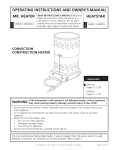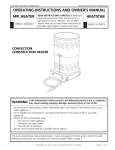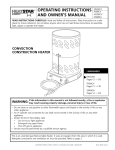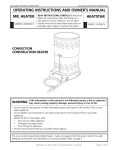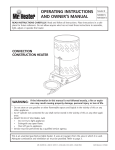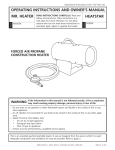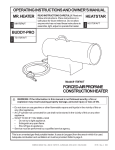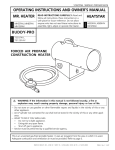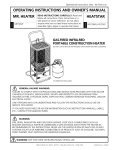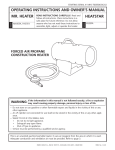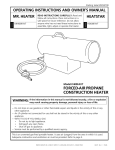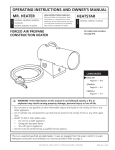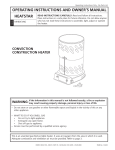Download Mr. Heater MH80CV Operating instructions
Transcript
Operational Instructions Only - No Parts List Operating Instructions and Owner’s Manual MR. HEATER HEATSTAR Model Model MH80CV, MH200CV READ INSTRUCTIONS CAREFULLY: Read and follow all instructions. Place instructions in a safe place for future reference. Do not allow anyone who has not read these instructions to assemble, light, adjust or operate the heater. HS80CV, HS200CV CONVECTION CONSTRUCTION HEATER If the information in this manual is not followed exactly, a fire or explosion WARNING: may result causing property damage, personal injury or loss of life. — Do not store or use gasoline or other flammable vapors and liquids in the vicinity of this or any other appliance. — An LP cylinder not connected for use shall not be stored in the vicinity of this or any other appliance. — WHAT TO DO IF YOU SMELL GAS • Do not try to light appliance. • Extinguish any open flame. • Shut off gas to appliance. — Service must be performed by a qualified service agency. This is an unvented gas-fired portable heater. It uses air (oxygen) from the area in which it is used. Adequate combustion and ventilation air must be provided. Refer to page 3. Enerco GROUP, INC., 4560 W. 160TH ST., CLEVELAND, OHIO 44135 • 216-916-3000 70486 Rev. D 04/08 WARNING: WARNING: YOUR SAFETY IS IMPORTANT TO YOU AND TO OTHERS, SO PLEASE READ THESE INSTRUCTIONS BEFORE YOU OPERATE THIS HEATER. FIRE, BURN, INHALATION, AND EXPLOSION HAZARD. KEEP SOLID COMBUSTIBLES, SUCH AS BUILDING MATERIALS, PAPER OR CARDBOARD, A SAFE DISTANCE AWAY FROM THE HEATER AS RECOMMENDED BY THE INSTRUCTIONS NEVER USE THE HEATER IN SPACES WHICH DO OR MAY CONTAIN VOLATILE OR AIRBORNE COMBUSTIBLES, OR PRODUCTS SUCH AS GASOLINE, SOLVENTS, PAINT THINNER, DUST PARTICLES OR UNKNOWN CHEMICALS. GENERAL HAZARD WARNING: FAILURE TO COMPLY WITH THE PRECAUTIONS AND INSTRUCTIONS PROVIDED WITH THIS HEATER, CAN RESULT IN DEATH, SERIOUS BODILY INJURY AND PROPERTY LOSS OR DAMAGE FROM HAZARDS OF FIRE, EXPLOSION, BURN, ASPHYXIATION, CARBON MONOXIDE POISONING, AND/OR ELECTRICAL SHOCK. ONLY PERSONS WHO CAN UNDERSTAND AND FOLLOW THE INSTRUCTIONS SHOULD USE OR SERVICE THIS HEATER. IF YOU NEED ASSISTANCE OR HEATER INFORMATION SUCH AS AN INSTRUCTIONS MANUAL, LABELS, ETC. CONTACT THE MANUFACTURER. THE STATE OF CALIFORNIA REQUIRES THE FOLLOWING WARNING: WARNING: Combustion by-products produced when using this product contain carbon monoxide, a chemical known to the State of California to cause cancer and birth defects (or other reproductive harm). WARNING: NOT FOR HOME OR RECREATIONAL VEHICLE USE TABLE OF CONTENTS SPECIFICATIONS HEATER SPECIFICATIONS............................................................. 2 Type of Gas:........For use with Propane Only WARNINGS................................................................................. 2 Gas Supply Pressure to regulator.........Max.: Bottle Pressure........Min.: 80CV = 5 psig (34.5 kPa) Min.: 200CV = 15 psig (103 kPa) OPERATING PRECAUTIONS......................................................... 3 SAFETY PRECAUTIONS................................................................ 3 ODOR FADE WARNING............................................................... 4 CAUTION: SHELL EXTENSION INSTRUCTIONS............................. 5 regulator out.......80CV................................200CV = 11" W.C. (2.74 kPa) = 10 psig (68.9 kPa) OPERATING INSTRUCTIONS........................................................ 6 SERVICING.................................................................................. 6 Ignition:...............Piezo Ignitor SIZE AND CAPACITY OF PROPANE CYLINDERS REQUIRED........... 7 200CV - PARTS............................................................................ 9 Minimum Ambient Temp. Rating.......0°F (-17.8°C) WARRANTY...............................................................................12 Model:................80CV................................ 200CV INSTRUCTIONS FOR ORDERING PARTS . ....................................12 Rating:.................30,000-80,000 Btu/hr . ....75,000-200,000 Btu/hr (8.79 - 23.4 kW) (22.0 - 58.6 kW) 80CV - PARTS.............................................................................. 8 Fuel Consumption:......1.4 to 3.7 #/hr..................3.5 - 9.3 #/hr (.74 – 1.80 kg/hr) (1.44 - 4.32 kg/hr) Fuel Orifice Port No.:..............6......................................6 Fuel Orifice Port Size:.............0.0472" . ..........................0.0320" (1.20mm) (.813mm) Enerco Group, Inc. |Convection Construction Heater 2 Operating Instructions and Owner’s Manual 70486 Rev. D 04/08 OPERATING PRECAUTIONS SAFETY PRECAUTIONS 1. Check the heater thoroughly for damage. DO NOT operate a damaged heater. 2. DO NOT modify the heater or operate a heater which has been modified from its original condition. 3. DO NOT light or operate heater unless the shells are fully extended and locked into position. See enclosed assembly sheet for instructions. 4. Use only propane gas. 5. Use only VAPOR WITHDRAWAL propane supply. If there is any question about vapor withdrawal, ask your propane dealer. 6. Mount the propane cylinders vertically (shutoff valve up). Secure them from falling or being knocked over and protect them from damage. 7. Locate propane containers at least (USA) 7 ft. (2.13m) for 80CV and 9 ft. (2.7m) for 200CV (Canada)10 ft. (3m) from the heater and do not direct exhaust toward containers. 8. IMPORTANT Use only the hose and regulator assembly provided with the heater. Match the color stripe on the hangtag attached to the hose assembly with the color on the label located near the propane inlet fitting on the heater. Inspect hose assembly before each use of the heater. If there is excessive abrasion or wear, or hose is cut, replace with hose assembly listed on parts list before using heater. 9. For indoor use only. Area must be well ventilated. Figure 1. (also see "Operating Precautions"). 10. If at any time gas odor is detected, IMMEDIATELY DISCONTINUE operation until the source of gas has been located and corrected. Read enclosed Odor fade and Propane Sheet for additional information about detecting propane leaks. 11. Install the heater such that it is not directly exposed to water spray, rain and/or dripping water. 12. Maintain minimum clearance from normal combustible material (like paper). Figure 2. 13. Due to the high surface and exhaust temperatures, adults and children must observe clearances to avoid burns or clothing ignition. 14. Operate only on a stable, level surface. 15. Do not use with duct work. Do not restrict inlet or exit. 16. Do not move, handle or service while hot or burning. 17. Use only in accordance with local codes or, in the absence of local codes, with the Standard for the Storage and Handling of Liquefied Petroleum Gases ANSI/ NFPA 58 and CSA B149.1, Natural Gas and Propane Installation Code. This is a propane, direct-fired, convection heater. It's intended use is primarily temporary heating of buildings under construction, alteration or repair. Propane is heavier than air. If propane leaks from a connection or fitting, it sinks to the floor, collecting there with the surrounding air, forming a potentially explosive mixture. Obviously, propane leaks should be avoided, so set up the propane supply with utmost care. Read enclosed Odor Fade and Propane Sheet for additional information about detecting propane leaks. Leak check new connections or reconnections with a soap and water solution and follow all connection instructions herein. Also, ask your propane dealer for advice on the propane application and supply installation and ask him to check it if there are any questions. This heater was designed and certified for use as a construction heater in accordance with ANSI Standard Z83.7/CGA 2.14-2000. Check with your local fire safety authority if you have any questions about your applications. Other standards govern the use of fuel gases and heat producing products in specific applications. Your local authority can advise you about these. Direct-Fired means that all of the combustion products enter the heated space. Even though this heater operates very close to 100 percent combustion efficiency, it still produces small amounts of carbon monoxide. Carbon monoxide (called CO) is toxic. We can tolerate small amounts but not a lot. CO can build up in a heated space and failure to provide adequate ventilation could result in death. The symptoms of inadequate ventilation are: • headache • dizziness • burning eyes and nose • nausea • dry mouth or sore throat So, be sure to follow advice about ventilation in these operating instructions. When the heater is to be operated in the presence of other people the user is responsible for properly acquainting those present with the safety precautions and instructions, and of the hazards involved. Figure 1 VENTILATION: Minimum openings required Heater Opening near floor Opening near ceiling Convection 80CV, 200CV..................2 ft2. ..................2 ft2 Figure 2 MINIMUM CLEARANCE: From normal combustible material Clearance 80CV, 200CV Convection From sides...................................................4 ft From top......................................................6 ft CAUTION! FAILURE TO FOLLOW THESE VENTILATION REQUIREMENTS Locate 10' from canvas or plastic tarpaulins or similar coverings and secure them to prevent flapping or movement due to wind action. MAY RESULT IN SOOTING DAMAGE. Enerco Group, Inc. | Convection Construction Heater 3 Operating Instructions and Owner’s Manual 70486 Rev. D 04/08 ODOR FADE WARNING ODOR FADING ‑ NO ODOR DETECTED •Some people cannot smell well. Some people cannot smell the odor of the man‑made chemical added to propane (LP) or natural gas. You must determine if you can smell the odorant in these fuel gases. •Learn to recognize the odor of propane (LP) gas and natural gas. Local propane (LP) gas dealers will be more than happy to give you a scratch and sniff pamphlet. Use it to become familiar with the fuel gas odor. •Smoking can decrease your ability to smell. Being around an odor for a period of time can affect your sensitivity to that particular odor. Odors present in animal confinement buildings can mask fuel gas odor. •The odorant in propane (LP) gas and natural gas is colorless and the intensity of its odor can fade under some circumstances. •If there is an underground leak, the movement of gas through the soil can filter the odorant. •Propane (LP) gas odor may differ in intensity at different levels. Since Propane (LP) gas is heavier than air, there may be more odor at lower levels. •Always be sensitive to the slightest gas odor. If you continue to detect any gas odor, no matter how small, treat it as a serious leak. Immediately go into action as discussed previously. WARNING Asphyxiation Hazard •Do not use this heater for heating human living quarters. •Do not use in unventilated areas. •The flow of combustion and ventilation air must not be obstructed. •Proper ventilation air must be provided to support the combustion air requirements of the heater being used. •Refer to the specification section of the heater’s manual, heater data plate, or contact the factory to determine combustion air ventilation requirements of the heater. •Lack of proper ventilation air will lead to improper combustion. •Improper combustion can lead to carbon monoxide poisoning leading to serious injury or death. Symptom of carbon monoxide poisoning can include headaches dizziness and difficulty in breathing. FUEL GAS ODOR LP gas and natural gas have man‑made odorants added specifically for detection of fuel gas leaks. If a gas leak occurs you should be able to smell the fuel gas. Since Propane (LP) is heavier than air you should smell for the gas odor low to the floor. ANY GAS ODOR IS YOUR SIGNAL TO GO INTO IMMEDIATE ACTION! •Do not take any action that could ignite the fuel gas. Do not operate any electrical switches. Do not pull any power supply or extension cords. Do not light matches or any other source of flame. Do not use your telephone. •Get everyone out of the building and away from the area immediately. •Close all propane (LP) gas tank or cylinder fuel supply valves, or the main fuel supply valve located at the meter if you use natural gas. •Propane (LP) gas is heavier than air and may settle in low areas. When you have reason to suspect a propane leak, keep out of all low areas. •Use your neighbor’s phone and call your fuel gas supplier and your fire department. Do not re‑enter the building or area. •Stay out of the building and away from the area until declared safe by the firefighters and your fuel gas supplier. •FINALLY, let the fuel gas service person and the firefighters check for escaped gas. Have them air out the building and area before you return. Properly trained service people must repair any leaks, check for further leakages, and then relight the appliance for you. Enerco Group, Inc. |Convection Construction Heater ATTENTION ‑ CRITICAL POINTS TO REMEMBER! •Propane (LP) gas has a distinctive odor. Learn to recognize these odors. (Reference Fuel Gas Odor and Odor Fading sections above. •Even If you are not properly trained in the service and repair of the heater, ALWAYS be consciously aware of the odors of propane (LP) gas and natural gas. •If you have not been properly trained in repair and service of propane (LP) gas then do not attempt to light heater, perform service or repairs, or make any adjustments to the heater on the propane (LP) gas fuel system. •A periodic sniff test around the heater or at the heater’s joints; i.e. hose, connections, etc., is a good safety practice under any conditions. If you smell even a small amount of gas, CONTACT YOUR FUEL GAS SUPPLIER IMMEDIATELY. DO NOT WAIT! 4 Operating Instructions and Owner’s Manual 70486 Rev. D 04/08 CAUTION: NEVER IGNITE AND / OR RUN THIS HEATER UNLESS THE SHELLS ARE FULLY EXTENDED AND LOCKED INTO POSITION. STEP 2: LIFT OUTER SHELL STRAIGHT UP. CARE MUST BE TAKEN TO PROTECT HANDS DURING LIFT. STEP 1: HEATER AS RECEIVED OUT OF BOX. BEFORE LIFTING OUTER SHELL PROTECT HANDS. NEVER GRASP BARE METAL WITHOUT HAND PROTECTION. Lock shells together and clips in place with screws in each clip. 3 Screws Total. Make sure clip goes into slot in lower shell. 3 Places STEP 4: LOCK THE CLIP INTO PLACE WITH 3 SCREWS AS SHOWN. THE HEATER MUST NOT BE OPERATED UNLESS THE OUTER SHELL IS PROPERLY EXTENDED AND FULLY LOCKED INTO PLACE. STEP 3: LIFT OUTER SHELL UNTIL ALL THREE CLIPS ENGAGE SLOTS IN LOWER SHELL. WHEN THIS HAPPENS, THE SCREW HOLES WILL LINE UP. CAUTION: NEVER IGNITE AND / OR RUN THIS HEATER UNLESS THE SHELLS ARE FULLY EXTENDED AND LOCKED INTO POSITION. Enerco Group, Inc. | Convection Construction Heater 5 Operating Instructions and Owner’s Manual 70486 Rev. D 04/08 OPERATING INSTRUCTIONS MAINTENANCE AND STORAGE PREPARING FOR OPERATION 1. 1. Extend the shell fully and lock into place as shown in the enclosed instructions sheet before lighting or operating the heater. 2.Before each use, check the soft "O" ring seat at the bullnose of the POL fitting. If the "O" ring is cut, scuffed, or otherwise damaged, replace it with part number 6681. 2. Check the heater for possible shipping damage. If any is found, immediately notify the factory. 3. Turn off the gas at the LP-gas supply cylinder(s) when the heater is not in use. 3. Follow all of the Safety and Operating Precautions. 4. When the heater is to be stored indoors, the connection between the LP-gas supply cylinder(s) and the heater must be disconnected and the cylinder(s) removed from the heater and stored out of doors and in accordance with Chapter 5 of the standard for Storage and Handling of Liquefied Petroleum Gases ANSI/NFPA 58 and CSA B149.1,Natural Gas and Propane Installation Code. 4.Connect the POL fitting of hose and regulator assembly to the propane cylinder by rotating the POL nut counterclockwise into the propane cylinder's valve outlet and securely tighten with a wrench. 5.Connect the hose to the heater. 6. Securely tighten all gas connections. 7. Open the cylinder's gas valve and check all gas connections with a soap and water solution. DO NOT USE A FLAME. SERVICING START 1. A hazardous condition may result if a heater is used that has been modified or is not functioning properly. When the heater is working properly: WARNING: BEFORE LIGHTING PILOT, fully close the ball valve (turn knob fully clockwise). * The flame is contained within the heater. 2.Fully open the valve on the propane cylinder and wait 15 seconds before Step 3. * The flame is essentially blue with perhaps some yellow tipping. 3. Depress red button on safety pilot valve admitting gas to the heater. Then push and release the ignition button until the pilot lights. * There is no strong disagreeable odor, eye burning or other physical discomfort. * There is no smoke or soot internal or external to the heater. 4. When the pilot lights, continue to hold the button depressed for 30 seconds, then release. * There are no unplanned or unexplained shut downs of the heater. 5. If pilot goes out, wait 5 minutes and repeat the lighting procedure. The parts lists and exploded view show the heater as it was constructed. Do not use a heater which is different from that shown. In this regard, use only the hose, regulator and cylinder connection fitting (called a POL fitting) supplied with the heater. IMPORTANT Match the color stripe on the hang tag attached to the hose assembly with the color on the label located near the propane inlet fitting on the heater. Do not use alternates. For this heater, the regulator must be set as shown in "specifications". If there is any uncertainty about the regulator setting, have it checked. 6. When the pilot remains lit, open the ball valve (turn knob counter clockwise) to light main burner. Partially close valve to regulate heat output. CAUTION: ADJUSTING BURN RATE too low can cause soot. Watch for and avoid a yellow smoky flame. STOP 1. Securely close valve on the propane cylinder. A heater which is not working right must be repaired, but only by a trained, experienced service person. 2. Continue to operate heater until all fuel in the hose has burned. In-warranty products will be repaired with no charge for either parts or labor. Please include a brief statement indicating date, place of purchase, the nature of the problem and proof of purchase. 3. Fully close the ball valve. RESTART AFTER SAFETY SHUTDOWN 1. The heater should be inspected before each use, and at least annually by a qualified person. Securely close valve at propane cylinder. Out-of-warranty products will be repaired with a charge for parts and labor. 2. Wait 5 minutes. 3. Restart following "Start" procedure. Enerco Group, Inc. |Convection Construction Heater 6 Operating Instructions and Owner’s Manual 70486 Rev. D 04/08 SIZE AND CAPACITY OF PROPANE CYLINDERS REQUIRED The charts below show the approximate size of the cylinder required for these heaters. To use the chart: 1. Select the lowest air temperature expected (at the bottom of the chart). 2. Move straight up to time of operation desired (left side of chart). 3. Read the cylinder size required. All heaters should have: full cylinders good air circulation no frost on cylinders 80CV 200CV Fuel Cylinder Capacity: 100# Enerco Group, Inc. | Convection Construction Heater 7 Operating Instructions and Owner’s Manual 70486 Rev. D 04/08 Enerco Group, Inc. |Convection Construction Heater 8 Operating Instructions and Owner’s Manual 70486 Rev. D 04/08 Enerco Group, Inc. | Convection Construction Heater 9 Operating Instructions and Owner’s Manual 70486 Rev. D 04/08 Operating Instructions and Owner’s Manual MR. HEATER HEATSTAR Model Model MH80CV, MH200CV READ INSTRUCTIONS CAREFULLY: Read and follow all instructions. Place instructions in a safe place for future reference. Do not allow anyone who has not read these instructions to assemble, light, adjust or operate the heater. HS80CV, HS200CV WARNING: USE ONLY MANUFACTURER’S REPLACEMENT PARTS. USE OF ANY OTHER PARTS COULD CAUSE INJURY OR DEATH. REPLACEMENT PARTS ARE ONLY AVAILABLE DIRECT FROM THE FACTORY AND MUST BE INSTALLED BY A QUALIFIED SERVICE AGENCY. PARTS ORDERING INFORMATION: PURCHASING: Accessories may be purchased at any Mr. Heater/HeatStar local dealer or direct from the factory FOR INFORMATION REGARDING SERVICE Please call Toll-Free 800-251-0001 • www.enerco-mrheater.com Our office hours are 8:30 AM – 5:00 PM, EST, Monday through Friday. Please include the model number, date of purchase, and description of problem in all communication. LIMITED WARRANTY The company warrants this product to be free from imperfections in material or workmanship, under normal and proper use in accordance with instructions of The Company, for a period of one year from the date of delivery to the buyer. The Company, at its option, will repair or replace products returned by the buyer to the factory, transportation prepaid within said one year period and found by the Company to have imperfections in material or workmanship. If a part is damaged or missing, call our Technical Support Department at 800-251-0001. Address any Warranty Claims to the Service Department, Enerco Group, Inc., 4560 W. 160TH ST., CLEVELAND, OHIO 44135. Include your name, address and telephone number and include details concerning the claim. Also, supply us with the purchase date and the name and address of the dealer from whom you purchased our product. The foregoing is the full extent of the responsibility of the Company. There are no other warranties, express or implied. Specifically there is no warranty of fitness for a particular purpose and there is no warranty of merchantability. In no event shall the Company be liable for delay caused by imperfections, for consequential damages, or for any charges of the expense of any nature incurred without its written consent. The cost of repair or replacement shall be the exclusive remedy for any breach of warranty. There is no warranty against infringement of the like and no implied warranty arising from course of dealing or usage of trade. This warranty will not apply to any product which has been repaired or altered outside of the factory in any respect which in our judgment affects its condition or operation. Some states do not allow the exclusion or limitation of incidental or consequential damages, so the above limitation or exclusion may not apply to you. This Warranty gives you specific legal rights, and you may have other rights which vary from state to state. Enerco Group, Inc., reserves the right to make changes at any time, without notice or obligation, in colors, specifications, accessories, materials and models. ® ® ANSI Z83.7/CGA 2.14-2000 Enerco GROUP, INC., 4560 W. 160TH ST., CLEVELAND, OHIO 44135 • 216-916-3000 Enerco is a registered trademark of Enerco Group, Inc. © 2006, Enerco/Mr. Heater. All rights reserved Enerco Group, Inc. |Convection Construction Heater 10 Operating Instructions and Owner’s Manual 70486 Rev. D 04/08 GUIDE D'UTILISATION ET INSTRUCTIONS DE FONCTIONNEMENT MR. HEATER MODÈLE LISEZ SOIGNEUSEMENT LES INSTRUCTIONS : Conservez les instructions en sécurité pour vous y référer ultérieurement. Interdisez à quiconque n'ayant pas lu les présentes instructions d'assembler, d'allumer, de régler ou de faire fonctionner cet appareil de chauffage. MODÈLE MH80CV, MH200CV HEATSTAR HS80CV, HS200CV AVERTISSEMENT : N'UTILISEZ QUE LES PIÈCES DE REMPLACEMENT DU FABRICANT. L'UTILISATION D'AUTRES PIÈCES RISQUE DE CAUSER DES BLESSURES ET LA MORT. LES PIÈCES DE REMPLACEMENT NE SONT OFFERTES QUE PAR LE FABRICANT ET DOIVENT ÊTRE INSTALLÉES PAR UNE ENTREPRISE SPÉCIALISÉE. INFORMATIONS SUR LA COMMANDE DE PIÈCES : ACHAT : On peut se procurer les accessoires par l'entremise de tous les détaillants locaux Mr. Heater/HeatStar ou directement du fabricant. POUR OBTENIR DES INFORMATIONS SUR LE SERVICE Appelez sans frais au 800-251-0001 • www.enerco-mrheater.com Nos heures d'ouverture sont de 8 h 30 à 17 h HE, du lundi au vendredi. Veuillez indiquer le numéro du modèle, la date d'achat et la description du problème dans toutes vos communications avec nous. GARANTIE LIMITÉE L'entreprise garantit ce produit contre tout défaut de matériel ou de main-d'œuvre, dans des conditions d'utilisation normale et adéquate, conformément aux instructions de l'entreprise, pour une période de un an à compter de la date de livraison à l'acheteur. L'entreprise réparera ou remplacera, à sa discrétion, les produits retournés port payé par l'acheteur au fabricant dans la période de un an et jugés par l'entreprise comme présentant des défauts de matériel ou de main-d'œuvre. Si une pièce est endommagée ou manquante, téléphonez à notre service de soutien technique au 800-251-0001. Adressez toute réclamation relative à la garantie à Service Department, Enerco Group, Inc., 4560 W. 160TH ST., CLEVELAND, OHIO 44135 États-Unis. Indiquez vos nom, adresse et numéro de téléphone ainsi que les détails de la réclamation. Indiquez-nous également la date d'achat et le nom et l'adresse du détaillant de qui vous avez acheté le produit. Ce qui est énoncé ci-dessus constitue la responsabilité totale de l'entreprise. Il n'existe aucune autre garantie, expresse ou tacite. Plus précisément, il n'y a aucune garantie concernant l'adéquation à une utilisation particulière ni aucune garantie concernant la qualité marchande. En aucun cas l'entreprise ne sera tenue responsable des retards causés par des défectuosités, ni des dommages indirects, ni des dépenses encourues sans son consentement écrit, quelle que soit leur nature. Le coût de la réparation ou du remplacement sera le seul recours possible en cas de violation de garantie. Il n'y a aucune garantie contre une transgression de ce genre ni aucune garantie tacite découlant des usages du commerce ou de la façon habituelle d'échanger. La présente garantie ne s'applique à aucun produit qui a été réparé ou modifié par d'autres que le fabricant si cela influe de quelque façon que ce soit sur la condition de l'appareil ou son fonctionnement, selon notre jugement. Certains États ou provinces ne permettent pas d'exclure ou de limiter les dommages indirects ou subséquents. Par conséquent, les limitations ou exclusions ci-dessus mentionnées ne vous concernent peut-être pas. La présente garantie vous accorde des droits juridiques précis, mais vous pourriez avoir d'autres droits qui varient selon la province ou l'État. Enerco Group Inc. se réserve le droit d'effectuer des modifications en tout temps, sans préavis ni obligation, aux couleurs, aux spécifications, aux accessoires, aux matériaux et aux modèles. ® ® ANSI Z83.7/CGA 2,14-2000 ENERCO GROUP, INC., 4560 W. 160TH ST., CLEVELAND, OHIO 44135 É.-U. • (216) 916-3000 Enerco est une marque de commerce déposée d'Enerco Group Inc. © 2006, Enerco/Mr. Heater. Tous droits réservés. Enerco Group, Inc. |Appareil de chauffage à convection pour chantier de construction 10 Guide d'utilisation et instructions de fonctionnement Version 04/08 L2 nº 70486 Enerco Group, Inc. |Appareil de chauffage à convection pour chantier de construction 9 Guide d'utilisation et instructions de fonctionnement Version 04/08 L2 nº 70486 Enerco Group, Inc. |Appareil de chauffage à convection pour chantier de construction 8 Guide d'utilisation et instructions de fonctionnement Version 04/08 L2 nº 70486 TABLEAU DE DIMENSIONS ET CONTENANCES DES BONBONNES DE GAZ PROPANE REQUISES Les tableaux qui suivent indiquent la taille approximative de la bonbonne de gaz requise pour ces appareils de chauffage. Pour utiliser le tableau : 1. Sélectionnez la température de l'air la plus basse prévue (au bas du tableau). 2. Allez ensuite directement au haut du tableau au temps d'utilisation désiré (côté gauche du tableau). 3.Notez la dimension de la bonbonne requise. Tous les appareils de chauffage doivent :être munis de bonbonnes pleines disposer d'une bonne circulation d'air ne présenter aucun signe de givre 80CV Enerco Group, Inc. |Appareil de chauffage à convection pour chantier de construction 7 200CV Guide d'utilisation et instructions de fonctionnement Version 04/08 L2 nº 70486 1. AVANT LE FONCTIONNEMENT ENTRETIEN ET ENTREPOSAGE INSTRUCTIONS DE FONCTIONNEMENT 1. Ouvrez complètement la coque et verrouillez-la tel qu'indiqué sur le feuillet d'instructions fourni avant d'allumer et de faire fonctionner l'appareil. 2. Vérifiez soigneusement tout dommage qu'aurait pu subir l'appareil de chauffage pendant l'expédition. Si vous en découvrez, avertissez immédiatement le fabricant. 3.Respectez toutes les précautions de sécurité et de fonctionnement. 4.Branchez le raccord POL (filet à gauche) du tuyau et du régulateur en tournant l'écrou POL en sens anti-horaire dans la sortie du robinet de la bonbonne de gaz propane, puis serrez-le avec une clé. 5.Raccordez le tuyau flexible à l'appareil. 6. Serrez fermement toutes les connexions de gaz. 7. Ouvrez le robinet de gaz de la bonbonne et vérifiez toutes les connexions au moyen d'un mélange d'eau et de savon. N'UTILISEZ PAS DE FLAMME. DÉMARRAGE 1. AVERTISSEMENT : AVANT D'ALLUMER LA VEILLEUSE, fermez complètement le clapet à bille (tournez le bouton en sens horaire). 2. Ouvrez complètement le robinet de la bouteille de gaz propane et attendez 15 secondes avant de procéder à l'étape 3. 3. Appuyez sur le bouton rouge de la veilleuse de sûreté pour que le gaz pénètre dans l'appareil. Appuyez ensuite sur le bouton d'allumage et maintenez-le enfoncé jusqu'à ce que la veilleuse s'allume. 4.Une fois la veilleuse allumée, maintenez le bouton enfoncé pendant 30 secondes, puis relâchez-le. 5. Si la veilleuse s'éteint, attendez 5 minutes avant de recommencer la méthode d'allumage. 6. Quand la veilleuse reste allumée, ouvrez le clapet à bille (tournez-le en sens anti-horaire) pour allumer le brûleur principal. Fermez partiellement le robinet pour régler le débit de chaleur. ATTENTION: LE TAUX AJUSTANT DE BRULURE trop bas peut causer de la suie. Guetter et éviter une flamme enfumée jaune. L'appareil de chauffage doit être vérifié avant chaque utilisation et au moins une fois par année par un technicien qualifié. 2. Avant chaque utilisation, vérifiez l'assise du joint torique souple à la partie arrondie du raccord POL (filet à gauche). Si le joint torique est coupé, usé ou endommagé de quelque façon, remplacez-le par la pièce n° 6681. 3. Coupez l'alimentation en gaz propane liquéfié quand l'appareil n'est pas utilisé. 4. Quand l'appareil de chauffage est rangé à l'intérieur, la connexion entre la bouteille d'alimentation en gaz basse pression et l'appareil doit être débranchée et la bouteille doit être retirée de l'appareil et rangée à l'extérieur, tel que précisé au chapitre 5 de la norme relative au rangement et à la manutention des produits de pétrole liquéfiés ANSI/NFPA 58 et CSA B149.1 du Code d'installation du gaz naturel et du gaz propane. VÉRIFICATION Un appareil de chauffage qui a été modifié ou qui ne fonctionne pas correctement risque d'être une cause de dangers. * La flamme reste dans l'appareil de chauffage. * La flamme a une teinte bleue avec une pointe de couleur jaune. * Il n'y a pas de forte odeur désagréable, pas de sensation de brûlure aux yeux, ni de malaise physique général. * Il n'y a pas de fumée ni de suie à l'intérieur ou à l'extérieur de l'appareil de chauffage. * Il ne se produit pas d'arrêts imprévus ou inexpliqués de l'appareil. La liste des pièces et le schéma du câblage illustrent la construction détaillée de l'appareil de chauffage. N'utilisez pas un appareil de chauffage qui diffère de ce qui est illustré. N'utilisez à cet effet que le tuyau, le régulateur et le raccord de bonbonne (appelé raccord POL) fournis avec l'appareil de chauffage. IMPORTANT Faire correspondre la bande de couleur de l'étiquette fixée au tuyau à la couleur de l'étiquette située près du raccord d'entrée de gaz propane. N'utilisez aucun élément de substitution. Sur cet appareil de chauffage, le régulateur doit être réglé tel qu'indiqué à la rubrique « Spécifications ». Si vous avez un doute au sujet du réglage du régulateur, faites-le vérifier. Les produits non couverts par la garantie seront réparés aux frais REDÉMARRAGE APRÈS UN ARRÊT D'URGENCE Les produits couverts par la garantie seront réparés sans frais, pièces et main-d'œuvre comprises. Veuillez joindre une courte description de la nature du problème avec la date, le lieu et la preuve d'achat. 3.Fermez complètement le clapet à bille. 2. Laissez l'appareil fonctionner jusqu'à ce que tout le gaz dans le tuyau ait brûlé. Si un appareil de chauffage ne fonctionne pas correctement, il doit être réparé, mais seulement par un technicien formé et expérimenté. ARRÊT 1. Fermez le robinet sur la bonbonne de gaz propane. 1.Fermez complètement le robinet sur la bonbonne de gaz propane. 2. Attendez cinq minutes. 3.Recommencez la procédure « DÉMARRAGE ». Enerco Group, Inc. |Appareil de chauffage à convection pour chantier de construction 6 Guide d'utilisation et instructions de fonctionnement Version 04/08 L2 nº 70486 ATTENTION : N'ALLUMEZ PAS L'APPAREIL ET NE LE FAITES PAS FONCTIONNER À MOINS QUE LA COQUE SOIT COMPLÈTEMENT OUVERTE ET VERROUILLÉE EN POSITION. ÉTAPE 1 : APPAREIL TEL QUE REÇU À LA SORTIE DE L'EMBALLAGE. AVANT DE SOULEVER LA COQUE EXTÉRIEURE, PROTÉGEZ-VOUS LES MAINS. NE SAISISSEZ JAMAIS LE MÉTAL NU SANS VOUS PROTÉGER LES MAINS. Assurez-vous que le clip est bien inséré dans la fente de la coque inférieure. ÉTAPE 2 : SOULEVEZ DIRECTEMENT LA COQUE EXTÉRIEURE. PROTÉGEZ-VOUS BIEN LES MAINS AVANT DE SOULEVER LA COQUE. Verrouillez les coques l'une à l'autre en plaçant une vis dans chaque clip. 3 vis en tout. 3 endroits ÉTAPE 3 : SOULEVEZ LA COQUE EXTÉRIEURE JUSQUÀ CE QUE LES TROIS CLIPS S'INSÈRENT DANS LES FENTES DE LA COQUE INFÉRIEURE. CECI ÉTANT FAIT, LES TROUS DES VIS DEVRAIENT ÊTRE ALIGNÉS. ÉTAPE 4 : VERROUILLEZ LES CLIPS AU MOYEN DES TROIS VIS, TEL QU'ILLUSTRÉ. L'APPAREIL NE DOIT PAS FONCTIONNER À MOINS QUE LES COQUES EXTÉRIEURES SOIENT COMPLÈTEMENT OUVERTES ET VERROUILLÉES EN POSITION. ATTENTION : N'ALLUMEZ PAS L'APPAREIL ET NE LE FAITES PAS FONCTIONNER À MOINS QUE LA COQUE SOIT COMPLÈTEMENT OUVERTE ET VERROUILLÉE EN POSITION. Enerco Group, Inc. |Appareil de chauffage à convection pour chantier de construction 5 Guide d'utilisation et instructions de fonctionnement Version 04/08 L2 nº 70486 AVERTISSEMENT LIÉ AUX SUBSTANCES ODORANTES AVERTISSEMENT Risque d'asphyxie •Cet appareil ne doit pas être utilisé pour le chauffage de locaux où demeurent des gens. •Ne l'utilisez pas dans des endroits non aérés. •Le débit de chaleur et d'air de ventilation ne doit pas être obstrué. •Le processus de combustion de cet appareil exige un apport adéquat en air de ventilation. •Consultez la rubrique portant sur les spécifications techniques dans le manuel de l'appareil ou sur la plaque de données de l'appareil, ou communiquez avec le fabricant pour obtenir les renseignements relatifs aux exigences en apport d'air de ventilation pour la combustion. •Le processus de combustion ne peut s'effectuer correctement si l'apport en air de ventilation est insuffisant. •Une combustion inadéquate produit des émanations nocives de monoxyde de carbone pouvant entraîner des troubles de santé graves, voire mortels. Les symptômes d'empoisonnement au monoxyde de carbone sont les maux de tête, les étourdissements et la difficulté respiratoire. ODEUR DU GAZ COMBUSTIBLE Des additifs odorants ont été ajoutés au gaz propane liquéfié et au gaz naturel dans le but de faciliter la détection de fuites. Vous devriez remarquer une odeur de gaz combustible s'il y a une fuite. Comme le gaz propane (liquéfié) est plus lourd que l'air, l'odeur de gaz se détecte plus facilement près du sol. TOUTE ODEUR DE GAZ EST UN SIGNAL QU'IL FAUT INTERVENIR IMMÉDIATEMENT! •Ne prenez aucune mesure qui provoquerait l'allumage des vapeurs de gaz. N'utilisez aucun interrupteur électrique. Ne tirez sur aucune source d'alimentation électrique ou rallonge électrique. N'allumez pas d'allumettes ni aucune source de flamme. N'utilisez pas votre téléphone. •Faites évacuer immédiatement toute personne se trouvant dans l'immeuble. •Fermez tous les robinets d'alimentation du réservoir de gaz propane (liquéfié) ou de la bonbonne, ainsi que le robinet d'alimentation principale situé sur le compteur, si vous utilisez du gaz naturel. •Le gaz propane (liquéfié) est plus lourd que l'air et peut s'accumuler dans les endroits près du sol. Si vous croyez qu'il y a une fuite de gaz propane, éloignez-vous des endroits plus bas. •Utilisez le téléphone d'un voisin et communiquez avec votre fournisseur en gaz combustible et votre service d'incendies. Ne retournez pas dans l'immeuble ou dans le secteur. •N'entrez pas dans l'immeuble et restez-en à l'écart jusqu'à ce que le personnel du service des incendies ou le fournisseur en gaz combustible ait confirmé que l'endroit ne comporte aucun risque. Enerco Group, Inc. |Appareil de chauffage à convection pour chantier de construction 4 •EN DERNIER LIEU, laissez le personnel du service des incendies ou d'approvisionnement en gaz combustible vérifier si du gaz s'échappe. Assurez-vous qu'ils aient aéré l'immeuble avant d'y retourner. Le personnel d'entretien expérimenté doit colmater toute fuite, vérifier la présence d'autres fuites, puis se charger d'allumer l'appareil pour vous. SUBSTANCE ODORANTE - AUCUNE ODEUR DÉCELÉE •Certaines personnes ne détectent pas bien les odeurs. Il est donc possible que certaines personnes ne puissent sentir la substance odorante ajoutée au gaz propane (liquéfié) ou au gaz naturel. Vous devez savoir si vous arrivez à déceler l'odeur de cette substance dans le gaz combustible. •Apprenez à reconnaître l'odeur du gaz propane et celle du gaz naturel. Pour ce faire, les détaillants de gaz propane (liquéfié) locaux seront heureux de vous fournir un feuillet comprenant une pastille à humer. Servez-vous de cette pastille pour vous aider à reconnaître l'odeur de gaz combustible. •Le tabagisme peut nuire à votre faculté olfactive. Votre facilité à déceler une odeur quelconque peut s'estomper si vous demeurez un certain temps dans un endroit où cette odeur est présente. La présence d'animaux dans des endroits clos peut aussi masquer l'odeur du gaz combustible. •La substance odorante contenue dans le gaz propane (liquéfié) et le gaz naturel est incolore et, selon certaines circonstances, son odeur pourrait s'estomper. •En cas de fuite souterraine, le déplacement du gaz dans le sol peut filtrer l'odeur. •L'intensité de l'odeur du gaz propane (liquéfié) peut varier à différents niveaux. Étant donné que le gaz propane (liquéfié) est plus lourd que l'air, l'odeur peut être plus prononcée à des niveaux inférieurs. •Portez toujours attention à la moindre odeur de gaz. Si une odeur de gaz persiste, même si elle est minime, agissez comme s'il s'agissait d'une fuite importante. Intervenez immédiatement tel que décrit précédemment. ATTENTION - POINTS ESSENTIELS À RETENIR! •Le gaz propane (liquéfié) dégage une odeur particulière. Apprenez à reconnaître cette odeur. Consultez les rubriques Odeur du gaz combustible et Substance odorante, ci-dessus. •Même si vous n'avez pas été formé pour effectuer l'entretien et la réparation de l'appareil, soyez TOUJOURS attentif aux odeurs que dégagent le gaz propane (liquéfié) et le gaz naturel. •Si vous n'êtes pas formé pour procéder à l'entretien et à la réparation des appareils au gaz propane (liquéfié), ne tentez pas d'allumer l'appareil, de le réparer ou de l'entretenir, ni d'apporter des réglages au système d'alimentation en gaz propane de l'appareil. •Peu importe les conditions, une bonne pratique de sécurité consiste à sentir de temps à autre autour de l'appareil, des raccords, du tuyau et autres éléments. Si vous décelez la moindre odeur de gaz, COMMUNIQUEZ IMMÉDIATEMENT AVEC VOTRE FOURNISSEUR EN GAZ Guide d'utilisation et instructions de fonctionnement Version 04/08 L2 nº 70486 PRÉCAUTIONS LIÉES AU FONCTIONNEMENT Cet appareil de chauffage à convection et à feu direct fonctionne au gaz propane. Il est destiné principalement à chauffer temporairement des édifices en construction, en rénovation ou en réparation. Le gaz propane est plus lourd que l'air. Si du gaz propane fuit d'une connexion ou d'un raccord, il se dirige vers le plancher, se mélange avec l'air ambiant et forme un mélange potentiellement explosif. Évidemment, les fuites de gaz propane devraient être évitées; il est donc important de raccorder l'alimentation en propane avec le plus grand soin. Veuillez lire le feuillet « Substance odorante et gaz propane » ci-joint pour obtenir plus de précisions relatives à la détection des fuites de gaz propane. Vérifiez la présence de fuite aux nouvelles connexions et raccords en utilisant un mélange d'eau et de savon et suivez les instructions mentionnées. Obtenez également les conseils de votre détaillant quant à votre installation au propane et posez-lui toute question que vous auriez à cet égard. Cet appareil a été conçu et homologué pour être utilisé comme appareil de chauffage pour chantier de construction, conformément à la norme Z83.7/CGA 2,14-2000 de l'ANSI. Soumettez à l'organisme local responsable de la sécurité et des incendies toute question relative à votre type d'installation. Selon le type d'application, d'autres normes peuvent s'appliquer et régir l'utilisation des produits de combustion, de gaz combustible et des appareils de chauffage. L'organisme local qui en est responsable saura vous conseiller à cet égard. Le fonctionnement à feu direct de cet appareil signifie que tous les produits de combustion se retrouvent dans l'air ambiant. Même si l'efficacité de combustion de l'appareil de chauffage est presque complète, il produit quand même de petites quantités de monoxyde de carbone. Le monoxyde de carbone (appelé CO) est toxique. Notre organisme ne peut en supporter que de faibles quantités. Il est possible que le CO s'accumule dans le local à chauffer. Une ventilation inadéquate pourrait ainsi causer la mort. Les symptômes ressentis en cas de ventilation inadéquate sont les suivants : PRÉCAUTIONS LIÉES À LA SÉCURITÉ 1. 2. 3. 4. 5. 6. 7. 8. 9. 10. 11. 12. 16. Assurez-vous donc de respecter les conseils au sujet de la ventilation mentionnés dans ces instructions. 15. mal de gorge ou bouche sèche • nausée • sensation de brûlure au nez et aux yeux • étourdissement • mal de tête • Lorsque l'appareil de chauffage doit fonctionner en présence d'autres personnes, l'utilisateur est responsable d'informer ces dernières des instructions et précautions liées à la sécurité et de les avertir des dangers inhérents. 13. 14. 17. Vérifiez attentivement si l'appareil de chauffage a subi des dommages. NE FAITES PAS fonctionner un appareil endommagé. NE MODIFIEZ PAS l'appareil de chauffage et ne le faites pas fonctionner s'il n'est plus dans son état d'origine. N'ALLUMEZ PAS l'appareil et ne le faites pas fonctionner à moins que la coque soit complètement ouverte et verrouillée en position. Consultez la feuille d'assemblage pour obtenir les instructions. Utilisez uniquement du gaz propane. Utilisez uniquement une alimentation au propane à ÉLIMINATION DES ÉMANATIONS. Si vous avez des questions à propos de l'élimination des émanations, consultez votre détaillant de gaz propane. Installez les bonbonnes de propane verticalement (robinet de fermeture vers le haut). Fixez-les comme il convient de sorte qu'ils ne puissent se décrocher accidentellement et protégez-les contre les dommages. Placez les réservoirs de gaz propane à une distance minimale (aux États-Unis) de 2,13 m (7 pi) pour le modèle 80CV et de 2,7 m (9 pi) pour le modèle 200CV, (au Canada) de 3 m (10 pi) de l'appareil de chauffage et n'orientez pas l'échappement directement vers les réservoirs. IMPORTANT Utilisez uniquement le tuyau et le régulateur fourni avec l'appareil. Faites correspondre la bande de couleur de l'étiquette fixée au tuyau à la couleur de l'étiquette située près du raccord d'entrée de gaz propane sur l'appareil. Inspectez le tuyau avant chaque utilisation de l'appareil de chauffage. En cas d'abrasion, d'usure excessive ou de coupure, remplacez le tuyau par l'ensemble de tuyaux recommandé avant d'utiliser l'appareil de chauffage. Pour utilisation intérieure seulement. La ventilation doit être adéquate. Figure 1. (voir également « Précautions liées au fonctionnement »). Si une odeur de gaz est détectée, ARRÊTEZ IMMÉDIATEMENT l'appareil de chauffage jusqu'à ce que la source d'émission du gaz ait été localisée et colmatée. Veuillez lire le feuillet « Substance odorante et gaz propane » ci-joint pour obtenir plus de précisions relatives à la détection des fuites de gaz propane. Installez l'appareil de chauffage de façon à ce qu'il ne soit pas exposé à l'eau. Conservez un écart minimal entre l'appareil et tout matériel combustible (tel que du papier). Figure 2. En raison des températures élevées de la surface et de l'échappement, les adultes et les enfants doivent respecter les distances de sécurité pour éviter des brûlures et l'inflammation des vêtements. Utilisez uniquement sur des surfaces stables et de niveau. N'utilisez pas l'appareil avec des conduits d'air. N'obstruez pas l'entrée et la sortie d'air. Ne déplacez pas l'appareil, ne le touchez pas et n'essayez pas d'en faire l'entretien alors qu'il est chaud. Utilisez l'appareil en observant les codes de sécurité en vigueur localement ou référez-vous aux normes relatives à l'entreposage et à la manutention des produits de pétrole liquéfiés ANSI/NFPA 58 et CSA B149.1 du Code d'installation du gaz naturel et du gaz propane. ÉCART MINIMUM : entre l'appareil et tout matériel combustible. VENTILATION : Ouvertures minimales requises Figure 2 Figure 1 Ouverture près Ouverture près du plafond Appareil de chauffage du plancher Appareil de chauffage Écart 80CV, 200CV Convection Des côtés.....................................................1,22 m (4 pi) Du dessus....................................................1,82 m (6 pi) Placez l'appareil à 3 m (10 pi) des bâches et des revêtements similaires, et fixez-les afin d'empêcher tout battement ou mouvement causé par le vent. Enerco Group, Inc. |Appareil de chauffage à convection pour chantier de construction 3 Guide d'utilisation et instructions de fonctionnement Version 05/06 L2 nº 70486 AVERTISSEMENT : VOTRE SÉCURITÉ PERSONNELLE ÉTANT IMPORTANTE POUR TOUS, VEUILLEZ LIRE LES INSTRUCTIONS AVANT D'UTILISER CET APPAREIL DE CHAUFFAGE. AVERTISSEMENT GÉNÉRAL DE DANGER : LE NON-RESPECT DES MESURES DE PRÉVENTION ET INSTRUCTIONS FOURNIES AVEC CET APPAREIL DE CHAUFFAGE RISQUE DE CAUSER LA MORT, DES BLESSURES GRAVES ET DES DOMMAGES OU DES PERTES MATÉRIELLES RÉSULTANT D'INCENDIE, D'EXPLOSION, DE BRÛLURE, D'ASPHYXIE, D'INTOXICATION AU MONOXYDE DE CARBONE OU D'ÉLECTROCUTION. SEULES LES PERSONNES APTES À COMPRENDRE ET À RESPECTER LES INSTRUCTIONS DEVRAIENT UTILISER OU EFFECTUER L'ENTRETIEN DE CET APPAREIL DE CHAUFFAGE. SI VOUS AVEZ BESOIN D'AIDE OU D'INFORMATION AU SUJET DE L'APPAREIL DE CHAUFFAGE (MANUEL D'INSTRUCTIONS, ÉTIQUETTES, ETC.), VEUILLEZ COMMUNIQUER AVEC LE FABRICANT. AVERTISSEMENT : AVERTISSEMENT : DANGER D'INCENDIE, D'EXPLOSION ET D'INHALATION CONSERVEZ LES MATÉRIAUX COMBUSTIBLES TELS QUE LES MATÉRIAUX DE CONSTRUCTION, LE PAPIER ET LE CARTON À UNE DISTANCE SÉCURITAIRE DE L'APPAREIL DE CHAUFFAGE COMME LE RECOMMANDENT LES INSTRUCTIONS. N'UTILISEZ JAMAIS L'APPAREIL DE CHAUFFAGE DANS UN LOCAL QUI CONTIENT OU RISQUE DE CONTENIR DES PARTICULES COMBUSTIBLES EN SUSPENSION DANS L'AIR OU DES PRODUITS TELS QUE DE L'ESSENCE, DES SOLVANTS, DU DILUANT À PEINTURE, DES PARTICULES DE POUSSIÈRE OU DES PRODUITS CHIMIQUES INCONNUS. L'ÉTAT DE LA CALIFORNIE IMPOSE L'AVERTISSEMENT SUIVANT : AVERTISSEMENT : L'UTILISATION DE CET APPAREIL CRÉE DES SOUSPRODUITS DE COMBUSTION CONTENANT DU MONOXYDE DE CARBONE, UN PRODUIT CHIMIQUE RECONNU PAR L'ÉTAT DE LA CALIFORNIE COMME CAUSE DE CANCER ET D'ANOMALIES CONGÉNITALES (OU AUTRES RISQUES POUR LA REPRODUCTION). Pression d'alimentation en gaz AVERTISSEMENTS ...................................................................... 2 Type de gaz :.......Pour utilisation de gaz propane seulement SPÉCIFICATIONS ........................................................................ 2 SPÉCIFICATIONS TABLE DES MATIÈRES PRÉCAUTIONS LIÉES AU FONCTIONNEMENT ............................. 3 au régulateur.............. Max. : Pression de la bonbonne. .Min. : 80CV = 34,5 kPa (5 lb/po²) Min. : 200CV = 103 kPa (15 lb/po²) Temp. ambiante DIMENSIONS ET CONTENANCES .............................................. 7 Allumage :...........Allumeur Piézo VÉRIFICATION............................................................................. 6 INSTRUCTIONS DE FONCTIONNEMENT . .................................... 6 à la sortie du régulateur... 80CV...........................................200CV ATTENTION : INSTRUCTIONS D'OUVERTURE DE LA COQUE ....... 5 AVERTISSEMENT LIÉ AUX SUBSTANCES ODORANTES ................ 4 PRÉCAUTIONS LIÉES À LA SÉCURITÉ . ........................................ 3 = 28 cm (11 po) W.C. (2,74 kPa = 68,9 kPa (10 lb/po²) évaluée à :..............30 000 à 80 000 BTU/h . .... 75 000 à 2 000 000 BTU/h (8,79 - 23,4 kW) (22,0 - 58,6 kW) INSTRUCTIONS POUR LA COMMANDE DE PIÈCES ....................10 Modèle :.............80CV................................ 200CV 200CV - PIÈCES .......................................................................... 9 minimale évaluée à....-17,8 °C (0 °F) 80CV - PIÈCES . .......................................................................... 8 GARANTIE ................................................................................10 Consommation de gaz :...............De 1,4 à 3,7 lb/h..............De 3,5 à 9,3 lb/h (de 0,74 à 1,80 kg/h) (de 1,44 à 4,32 kg/h) Dimension de de combustible :..6......................................6 Dimension de l'orifice :...............1,20 mm ..........................0 813 mm (0,0472 po) (0,0320 po) Enerco Group, Inc. |Appareil de chauffage à convection pour chantier de construction 2 Guide d'utilisation et instructions de fonctionnement Version 05/06 L2 nº 70486 GUIDE D'UTILISATION ET INSTRUCTIONS DE FONCTIONNEMENT MR. HEATER MODÈLE LISEZ SOIGNEUSEMENT LES INSTRUCTIONS : Conservez les instructions en sécurité pour vous y référer ultérieurement. Interdisez à quiconque n'ayant pas lu les présentes instructions d'assembler, d'allumer, de régler ou de faire fonctionner cet appareil de chauffage. MODÈLE MH80CV, MH200CV HEATSTAR HS80CV, HS200CV APPAREIL DE CHAUFFAGE À CONVECTION POUR CHANTIER DE CONSTRUCTION AVERTISSEMENT: Le non-respect des instructions, telles qu'indiquées dans le présent guide, risque d'entraîner une explosion ou un incendie entraînant des dommages matériels ou des blessures graves, voire mortelles. — N'entreposez ni n'utilisez d'essence ou autres liquides ou vapeurs inflammables à proximité de ce type d'appareil. — Aucune bonbonne de propane liquéfié non raccordée pour utilisation ne doit se trouver à proximité de cet appareil, ni d'aucun autre appareil. — EN PRÉSENCE D'UNE ODEUR DE GAZ • Ne tentez pas d'allumer l'appareil de chauffage. • Éteignez toute flamme nue. •Fermez l'alimentation en gaz à l'appareil. — L'entretien doit être effectué par un fournisseur de services d'entretien qualifié. Cet appareil de chauffage portatif alimenté au gaz n'est pas ventilé. Il utilise l'oxygène de l'air ambiant. Une circulation d'air adéquate doit être assurée pour la combustion et la ventilation. Voir page 3. ENERCO GROUP, INC., 4560 W. 160TH ST., CLEVELAND, OHIO 44135 É.-U. • (216) 881-5500 Version 04/08 L2 nº 70486




















